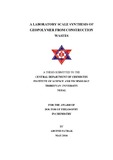Please use this identifier to cite or link to this item:
http://archive.nnl.gov.np:8080/handle/123456789/323| Title: | A laboratory scale synthesis of geopolymer from construction wastes |
| Authors: | Pathak, Arvind |
| Keywords: | Alkaline activator Compressive strength Construction and demolition waste Geopolymerisation Global warming |
| Issue Date: | 24-Dec-2018 |
| Abstract: | In the 21st century global warming becoming the most challenging problem, a huge amount of wastes are generated due to the rapid urbanization and construction of several new structures, renovation and demolition of old buildings especially in developing countries several million tons of construction and demolition wastes (CDW) globally. Much of the concrete waste from the construction industries is used as land filled, leading to environmental and ecological problems such as occupation of large areas of land, generation of dust, contamination of surface and underground water. Recently in Nepal after Gorkha earthquake on April 25 and its aftershocks a total of 4,784 public and 531,266 private buildings were either destroyed or damaged. The amount of such a large waste is creating economic burden as well as environmental pollution. This disaster compelled us for the complete utilization of these wastes generated for sustainable development due to the diminishing natural resources. Construction and demolition wastes are considered priority waste in European Union countries. As per Eurostat 2010, European Union generated 854.55 million tons of Construction and demolition waste. European Catalogue of Waste (ECW) has classified CDW in chapter 17 as Concrete (17 01 01), Bricks (17 01 02), Tiles and ceramics (17 01 03). The recycling of construction and demolition waste (CDW) is limited to the use of crushed aggregates in low-specification applications. Recycling and utilization of such waste would be a significant contribution to the environment and sustainable development towards the adoption of “zero waste” principle. These wastes are rich in SiO2 and Al2O3, which can be used as a raw material for the synthesis of geopolymer. One of the promising technology i.e., geopolymerisation has immense potential to convert such wastes into value added product. Geopolymerisation involves a chemical reaction between solid aluminosilicate oxides and alkaline activator solution at ambient or slightly elevated temperatures, resulting an amorphous to semicrystalline polymeric structure with Si–O–Al and Si–O–Si bonds of high mechanical strength. Four types of CDW were selected in this study. i.e., coal fly ash, demolished cement sand mixture, demolished cement sand concrete mixture and brick powder. Calorimetric analysis showed that brick dust is not very reactive. However the use of suitable additives, decrease in particle size of the raw material, appropriate ratio of activator solution, curing temperature and time enhances the mechanical properties of the geopolymer products. The compressive strength values of the geopolymer products were ranges from 8.35 to 60.00 MPa (NaOH, 6M; particle size, ≤53 m and Na2SiO3/BD-K = 1.5) at 28 days of curing at ambient temperature (40 °C). In case of temperature variation, the compressive strength values of the geopolymer products (BD-K2) found increasing from 9.40 to 23.47 MPa at 28 days of curing for 40 and 70 °C respectively for four hour followed by curing at room temperature (12±3 ºC). At Si/Al ratio equal to 3.16, the compressive strength values were found to be maximum, with the further increase in the ratio, the compressive strength values were found to be decreasing. A similar trend of result was found from the plot of compressive strength against SiO2/Al2O3 mass ratio. A maximum compressive strength was found at Na2O/SiO2 mass ratio equal to 0.58, below this ratio the compressive strength found to decrease. A lower Na2O/Al2O3 mass ratio was found favorable, a maximum compressive strength was found at Na2O/Al2O3 mass ratio equal to 0.23. The properties of geopolymers are found comparable with that of equivalent building materials. The structural changes in resulting geopolymer were studied using XRD, FTIR and SEM-EDX. The present study describes briefly the potential of geopolymer technology towards green buildings and future sustainable with a reduced carbon footprint. Such geopolymers can be used as a building material which can reduce the greenhouse gas emission as well as reduce the depletion of natural resources. |
| Description: | A thesis submitted for the award of Doctor of Philosophy in Chemistry to the Central Department of Chemistry, Institute of Science and Technology, Tribhuvan University, Nepal, 2016. |
| URI: | http://103.69.125.248:8080/xmlui/handle/123456789/323 |
| Appears in Collections: | 500 Natural sciences and mathematics |
Files in This Item:
| File | Description | Size | Format | |
|---|---|---|---|---|
| 1_Arvind Pathak_PhD Thesis.pdf | 5.22 MB | Adobe PDF |  View/Open |
Items in DSpace are protected by copyright, with all rights reserved, unless otherwise indicated.